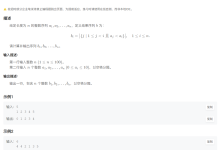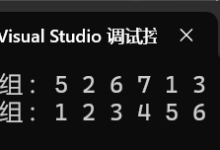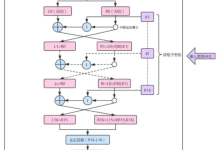文章目录
- 648. 单词替换
-
- 题目描述
- 示例 1:
- 示例 2:
- 提示:
- 解题思路
-
- 问题分析
- 核心思想
- 算法流程图
- 字典树搜索策略
- 算法优化策略
- 复杂度分析对比
- 算法实现要点
- 相关题目
- 完整题解代码
648. 单词替换
题目描述
在英语中,我们有一个叫做 词根(root) 的概念,可以词根 后面 添加其他一些词组成另一个较长的单词——我们称这个词为 衍生词 (derivative)。例如,词根 help,跟随着 继承词 “ful”,可以形成新的单词 “helpful”。
现在,给定一个由许多 词根 组成的词典 dictionary 和一个用空格分隔单词形成的句子 sentence。你需要将句子中的所有 衍生词 用 词根 替换掉。如果 衍生词 有许多可以形成它的 词根,则用 最短 的 词根 替换它。
你需要输出替换之后的句子。
示例 1:
输入:dictionary = [“cat”,“bat”,“rat”], sentence = “the cattle was rattled by the battery” 输出:“the cat was rat by the bat”
示例 2:
输入:dictionary = [“a”,“b”,“c”], sentence = “aadsfasf absbs bbab cadsfafs” 输出:“a a b c”
提示:
- 1 <= dictionary.length <= 1000
- 1 <= dictionary[i].length <= 100
- dictionary[i] 仅由小写字母组成。
- 1 <= sentence.length <= 10^6
- sentence 仅由小写字母和空格组成。
- sentence 中单词的总量在范围 [1, 1000] 内。
- sentence 中每个单词的长度在范围 [1, 1000] 内。
- sentence 中单词之间由一个空格隔开。
- sentence 没有前导或尾随空格。
解题思路
问题分析
这是一道经典的字典树(Trie)应用问题。需要将句子中的衍生词替换为最短的词根。关键是要找到每个单词的最短前缀匹配。
核心思想
算法流程图
#mermaid-svg-ROpkL2FloBUmVCA7 {font-family:\”trebuchet ms\”,verdana,arial,sans-serif;font-size:16px;fill:#333;}#mermaid-svg-ROpkL2FloBUmVCA7 .error-icon{fill:#552222;}#mermaid-svg-ROpkL2FloBUmVCA7 .error-text{fill:#552222;stroke:#552222;}#mermaid-svg-ROpkL2FloBUmVCA7 .edge-thickness-normal{stroke-width:2px;}#mermaid-svg-ROpkL2FloBUmVCA7 .edge-thickness-thick{stroke-width:3.5px;}#mermaid-svg-ROpkL2FloBUmVCA7 .edge-pattern-solid{stroke-dasharray:0;}#mermaid-svg-ROpkL2FloBUmVCA7 .edge-pattern-dashed{stroke-dasharray:3;}#mermaid-svg-ROpkL2FloBUmVCA7 .edge-pattern-dotted{stroke-dasharray:2;}#mermaid-svg-ROpkL2FloBUmVCA7 .marker{fill:#333333;stroke:#333333;}#mermaid-svg-ROpkL2FloBUmVCA7 .marker.cross{stroke:#333333;}#mermaid-svg-ROpkL2FloBUmVCA7 svg{font-family:\”trebuchet ms\”,verdana,arial,sans-serif;font-size:16px;}#mermaid-svg-ROpkL2FloBUmVCA7 .label{font-family:\”trebuchet ms\”,verdana,arial,sans-serif;color:#333;}#mermaid-svg-ROpkL2FloBUmVCA7 .cluster-label text{fill:#333;}#mermaid-svg-ROpkL2FloBUmVCA7 .cluster-label span{color:#333;}#mermaid-svg-ROpkL2FloBUmVCA7 .label text,#mermaid-svg-ROpkL2FloBUmVCA7 span{fill:#333;color:#333;}#mermaid-svg-ROpkL2FloBUmVCA7 .node rect,#mermaid-svg-ROpkL2FloBUmVCA7 .node circle,#mermaid-svg-ROpkL2FloBUmVCA7 .node ellipse,#mermaid-svg-ROpkL2FloBUmVCA7 .node polygon,#mermaid-svg-ROpkL2FloBUmVCA7 .node path{fill:#ECECFF;stroke:#9370DB;stroke-width:1px;}#mermaid-svg-ROpkL2FloBUmVCA7 .node .label{text-align:center;}#mermaid-svg-ROpkL2FloBUmVCA7 .node.clickable{cursor:pointer;}#mermaid-svg-ROpkL2FloBUmVCA7 .arrowheadPath{fill:#333333;}#mermaid-svg-ROpkL2FloBUmVCA7 .edgePath .path{stroke:#333333;stroke-width:2.0px;}#mermaid-svg-ROpkL2FloBUmVCA7 .flowchart-link{stroke:#333333;fill:none;}#mermaid-svg-ROpkL2FloBUmVCA7 .edgeLabel{background-color:#e8e8e8;text-align:center;}#mermaid-svg-ROpkL2FloBUmVCA7 .edgeLabel rect{opacity:0.5;background-color:#e8e8e8;fill:#e8e8e8;}#mermaid-svg-ROpkL2FloBUmVCA7 .cluster rect{fill:#ffffde;stroke:#aaaa33;stroke-width:1px;}#mermaid-svg-ROpkL2FloBUmVCA7 .cluster text{fill:#333;}#mermaid-svg-ROpkL2FloBUmVCA7 .cluster span{color:#333;}#mermaid-svg-ROpkL2FloBUmVCA7 div.mermaidTooltip{position:absolute;text-align:center;max-width:200px;padding:2px;font-family:\”trebuchet ms\”,verdana,arial,sans-serif;font-size:12px;background:hsl(80, 100%, 96.2745098039%);border:1px solid #aaaa33;border-radius:2px;pointer-events:none;z-index:100;}#mermaid-svg-ROpkL2FloBUmVCA7 :root{–mermaid-font-family:\”trebuchet ms\”,verdana,arial,sans-serif;}
是
否
是
否
开始
构建字典树
插入所有词根
分割句子为单词
遍历每个单词
在字典树中搜索最短词根
找到词根?
用词根替换单词
保持原单词
添加到结果
还有单词?
拼接结果字符串
结束
字典树搜索策略
#mermaid-svg-S2lCAnCDCtsd1ARy {font-family:\”trebuchet ms\”,verdana,arial,sans-serif;font-size:16px;fill:#333;}#mermaid-svg-S2lCAnCDCtsd1ARy .error-icon{fill:#552222;}#mermaid-svg-S2lCAnCDCtsd1ARy .error-text{fill:#552222;stroke:#552222;}#mermaid-svg-S2lCAnCDCtsd1ARy .edge-thickness-normal{stroke-width:2px;}#mermaid-svg-S2lCAnCDCtsd1ARy .edge-thickness-thick{stroke-width:3.5px;}#mermaid-svg-S2lCAnCDCtsd1ARy .edge-pattern-solid{stroke-dasharray:0;}#mermaid-svg-S2lCAnCDCtsd1ARy .edge-pattern-dashed{stroke-dasharray:3;}#mermaid-svg-S2lCAnCDCtsd1ARy .edge-pattern-dotted{stroke-dasharray:2;}#mermaid-svg-S2lCAnCDCtsd1ARy .marker{fill:#333333;stroke:#333333;}#mermaid-svg-S2lCAnCDCtsd1ARy .marker.cross{stroke:#333333;}#mermaid-svg-S2lCAnCDCtsd1ARy svg{font-family:\”trebuchet ms\”,verdana,arial,sans-serif;font-size:16px;}#mermaid-svg-S2lCAnCDCtsd1ARy .label{font-family:\”trebuchet ms\”,verdana,arial,sans-serif;color:#333;}#mermaid-svg-S2lCAnCDCtsd1ARy .cluster-label text{fill:#333;}#mermaid-svg-S2lCAnCDCtsd1ARy .cluster-label span{color:#333;}#mermaid-svg-S2lCAnCDCtsd1ARy .label text,#mermaid-svg-S2lCAnCDCtsd1ARy span{fill:#333;color:#333;}#mermaid-svg-S2lCAnCDCtsd1ARy .node rect,#mermaid-svg-S2lCAnCDCtsd1ARy .node circle,#mermaid-svg-S2lCAnCDCtsd1ARy .node ellipse,#mermaid-svg-S2lCAnCDCtsd1ARy .node polygon,#mermaid-svg-S2lCAnCDCtsd1ARy .node path{fill:#ECECFF;stroke:#9370DB;stroke-width:1px;}#mermaid-svg-S2lCAnCDCtsd1ARy .node .label{text-align:center;}#mermaid-svg-S2lCAnCDCtsd1ARy .node.clickable{cursor:pointer;}#mermaid-svg-S2lCAnCDCtsd1ARy .arrowheadPath{fill:#333333;}#mermaid-svg-S2lCAnCDCtsd1ARy .edgePath .path{stroke:#333333;stroke-width:2.0px;}#mermaid-svg-S2lCAnCDCtsd1ARy .flowchart-link{stroke:#333333;fill:none;}#mermaid-svg-S2lCAnCDCtsd1ARy .edgeLabel{background-color:#e8e8e8;text-align:center;}#mermaid-svg-S2lCAnCDCtsd1ARy .edgeLabel rect{opacity:0.5;background-color:#e8e8e8;fill:#e8e8e8;}#mermaid-svg-S2lCAnCDCtsd1ARy .cluster rect{fill:#ffffde;stroke:#aaaa33;stroke-width:1px;}#mermaid-svg-S2lCAnCDCtsd1ARy .cluster text{fill:#333;}#mermaid-svg-S2lCAnCDCtsd1ARy .cluster span{color:#333;}#mermaid-svg-S2lCAnCDCtsd1ARy div.mermaidTooltip{position:absolute;text-align:center;max-width:200px;padding:2px;font-family:\”trebuchet ms\”,verdana,arial,sans-serif;font-size:12px;background:hsl(80, 100%, 96.2745098039%);border:1px solid #aaaa33;border-radius:2px;pointer-events:none;z-index:100;}#mermaid-svg-S2lCAnCDCtsd1ARy :root{–mermaid-font-family:\”trebuchet ms\”,verdana,arial,sans-serif;}
搜索原则
是
否
是
否
找到第一个词根就返回
贪心策略
确保是最短的词根
最短优先
字典树搜索
从根节点开始
逐字符匹配
当前节点是词根结尾?
记录当前词根
继续向下搜索
还有字符且有子节点?
返回最短词根
算法优化策略
graph LR
A[优化方案] –> B[字典树方法]
A –> C[哈希表方法]
A –> D[排序+前缀匹配]
A –> E[字典排序优化]
B –> B1[时间O(N+M)]
B –> B2[空间O(词根总长度)]
B –> B3[最优解法]
C –> C1[时间O(N×M)]
C –> C2[空间O(词根总长度)]
C –> C3[实现简单]
D –> D1[时间O(M×logM+N×M)]
D –> D2[空间O(M)]
D –> D3[前缀排序]
E –> E1[时间O(N+M)]
E –> E2[空间O(词根总长度)]
E → E3[字典序优化]
style B fill:#c8e6c9
style C fill:#fff3e0
复杂度分析对比
graph TD
A[算法复杂度对比] –> B[字典树方法]
A –> C[哈希表暴力]
A –> D[排序前缀匹配]
A –> E[优化字典树]
A –> F[字符串匹配]
B –> B1[时间: O(N+M)]
B –> B2[空间: O(L)]
B –> B3[最优解法]
C –> C1[时间: O(N×M×K)]
C –> C2[空间: O(M×K)]
C –> C3[简单直接]
D –> D1[时间: O(M×logM+N×K)]
D –> D2[空间: O(M×K)]
D –> D3[排序优化]
E –> E1[时间: O(N+M)]
E –> E2[空间: O(L)]
E –> E3[提前终止]
F –> F1[时间: O(N×M×K)]
F –> F2[空间: O(1)]
F –> F3[会超时]
style B fill:#4caf50
style F fill:#f44336
subgraph "说明"
G[N: 句子长度]
H[M: 词根数量]
I[K: 平均词根长度]
J[L: 词根总长度]
end
算法实现要点
相关题目
- LeetCode 208. 实现 Trie (前缀树)
- LeetCode 211. 添加与搜索单词 – 数据结构设计
- LeetCode 720. 词典中最长的单词
- LeetCode 820. 单词的压缩编码
完整题解代码
package main
import (
"fmt"
"sort"
"strings"
"time"
)
// ========== 方法1: 字典树方法(推荐) ==========
// TrieNode 字典树节点
type TrieNode struct {
children [26]*TrieNode // 26个小写字母
isRoot bool // 是否为词根结尾
}
// newTrieNode 创建新的字典树节点
func newTrieNode() *TrieNode {
return &TrieNode{
children: [26]*TrieNode{},
isRoot: false,
}
}
// Trie 字典树
type Trie struct {
root *TrieNode
}
// newTrie 创建新的字典树
func newTrie() *Trie {
return &Trie{root: newTrieNode()}
}
// insert 插入词根到字典树
func (t *Trie) insert(root string) {
node := t.root
for i := 0; i < len(root); i++ {
index := root[i] – 'a'
if node.children[index] == nil {
node.children[index] = newTrieNode()
}
node = node.children[index]
}
node.isRoot = true
}
// findRoot 查找单词的最短词根
func (t *Trie) findRoot(word string) string {
node := t.root
for i := 0; i < len(word); i++ {
index := word[i] – 'a'
if node.children[index] == nil {
break
}
node = node.children[index]
// 找到词根,立即返回(保证最短)
if node.isRoot {
return word[:i+1]
}
}
return word // 没找到词根,返回原单词
}
func replaceWords1(dictionary []string, sentence string) string {
// 构建字典树
trie := newTrie()
for _, root := range dictionary {
trie.insert(root)
}
// 分割句子并替换
words := strings.Split(sentence, " ")
for i, word := range words {
words[i] = trie.findRoot(word)
}
return strings.Join(words, " ")
}
// ========== 方法2: 哈希表方法 ==========
func replaceWords2(dictionary []string, sentence string) string {
// 将词根存储到哈希表
rootSet := make(map[string]bool)
for _, root := range dictionary {
rootSet[root] = true
}
words := strings.Split(sentence, " ")
for i, word := range words {
// 逐个检查前缀
for j := 1; j <= len(word); j++ {
prefix := word[:j]
if rootSet[prefix] {
words[i] = prefix
break
}
}
}
return strings.Join(words, " ")
}
// ========== 方法3: 排序前缀匹配 ==========
func replaceWords3(dictionary []string, sentence string) string {
// 按长度排序,确保最短的词根优先匹配
sort.Slice(dictionary, func(i, j int) bool {
return len(dictionary[i]) < len(dictionary[j])
})
words := strings.Split(sentence, " ")
for i, word := range words {
for _, root := range dictionary {
if len(root) <= len(word) && strings.HasPrefix(word, root) {
words[i] = root
break // 找到最短的词根就停止
}
}
}
return strings.Join(words, " ")
}
// ========== 方法4: 优化字典树(提前终止) ==========
// TrieNode2 优化的字典树节点
type TrieNode2 struct {
children map[byte]*TrieNode2
isRoot bool
rootWord string // 直接存储词根
}
// newTrieNode2 创建优化的字典树节点
func newTrieNode2() *TrieNode2 {
return &TrieNode2{
children: make(map[byte]*TrieNode2),
isRoot: false,
rootWord: "",
}
}
// Trie2 优化的字典树
type Trie2 struct {
root *TrieNode2
}
// newTrie2 创建优化的字典树
func newTrie2() *Trie2 {
return &Trie2{root: newTrieNode2()}
}
// insert 插入词根(如果已存在更短的词根,不插入)
func (t *Trie2) insert(root string) {
node := t.root
for i := 0; i < len(root); i++ {
char := root[i]
// 如果当前路径上已经有词根,且更短,则不需要插入
if node.isRoot {
return
}
if node.children[char] == nil {
node.children[char] = newTrieNode2()
}
node = node.children[char]
}
// 标记为词根,并清空其子节点(因为我们只需要最短的)
node.isRoot = true
node.rootWord = root
node.children = make(map[byte]*TrieNode2)
}
// findRoot 查找最短词根
func (t *Trie2) findRoot(word string) string {
node := t.root
for i := 0; i < len(word); i++ {
char := word[i]
if node.children[char] == nil {
break
}
node = node.children[char]
if node.isRoot {
return node.rootWord
}
}
return word
}
func replaceWords4(dictionary []string, sentence string) string {
// 按长度排序,优先插入短的词根
sort.Slice(dictionary, func(i, j int) bool {
return len(dictionary[i]) < len(dictionary[j])
})
trie := newTrie2()
for _, root := range dictionary {
trie.insert(root)
}
words := strings.Split(sentence, " ")
for i, word := range words {
words[i] = trie.findRoot(word)
}
return strings.Join(words, " ")
}
// ========== 方法5: 字符串暴力匹配 ==========
func replaceWords5(dictionary []string, sentence string) string {
words := strings.Split(sentence, " ")
for i, word := range words {
minRoot := word
for _, root := range dictionary {
if len(root) < len(minRoot) && strings.HasPrefix(word, root) {
minRoot = root
}
}
words[i] = minRoot
}
return strings.Join(words, " ")
}
// ========== 工具函数 ==========
// 打印字典树结构
func (t *Trie) printTrie() {
fmt.Println("字典树结构:")
t.printTrieHelper(t.root, "", "")
}
func (t *Trie) printTrieHelper(node *TrieNode, prefix, indent string) {
if node.isRoot {
fmt.Printf("%s%s [词根]\\n", indent, prefix)
}
for i, child := range node.children {
if child != nil {
char := byte('a' + i)
t.printTrieHelper(child, prefix+string(char), indent+" ")
}
}
}
// 统计字典树节点数
func (t *Trie) countNodes() int {
return t.countNodesHelper(t.root)
}
func (t *Trie) countNodesHelper(node *TrieNode) int {
count := 1
for _, child := range node.children {
if child != nil {
count += t.countNodesHelper(child)
}
}
return count
}
// 获取所有词根
func (t *Trie) getAllRoots() []string {
var roots []string
t.getAllRootsHelper(t.root, "", &roots)
return roots
}
func (t *Trie) getAllRootsHelper(node *TrieNode, prefix string, roots *[]string) {
if node.isRoot {
*roots = append(*roots, prefix)
}
for i, child := range node.children {
if child != nil {
char := byte('a' + i)
t.getAllRootsHelper(child, prefix+string(char), roots)
}
}
}
// 生成测试数据
func generateTestCase(rootCount, sentenceLen int) ([]string, string) {
// 生成词根
roots := make([]string, rootCount)
chars := "abcdefghijklmnopqrstuvwxyz"
for i := 0; i < rootCount; i++ {
length := 2 + i%4 // 长度2-5
root := make([]byte, length)
for j := 0; j < length; j++ {
root[j] = chars[(i*3+j*7)%26]
}
roots[i] = string(root)
}
// 生成句子
words := make([]string, sentenceLen)
for i := 0; i < sentenceLen; i++ {
if i%3 == 0 && i/3 < len(roots) {
// 部分单词使用词根+后缀
root := roots[i/3]
suffix := "ing"
words[i] = root + suffix
} else {
// 随机单词
length := 3 + i%5
word := make([]byte, length)
for j := 0; j < length; j++ {
word[j] = chars[(i*5+j*11)%26]
}
words[i] = string(word)
}
}
return roots, strings.Join(words, " ")
}
// ========== 测试和性能评估 ==========
func main() {
// 测试用例
testCases := []struct {
name string
dictionary []string
sentence string
expected string
}{
{
name: "示例1: 基础替换",
dictionary: []string{"cat", "bat", "rat"},
sentence: "the cattle was rattled by the battery",
expected: "the cat was rat by the bat",
},
{
name: "示例2: 单字符词根",
dictionary: []string{"a", "b", "c"},
sentence: "aadsfasf absbs bbab cadsfafs",
expected: "a a b c",
},
{
name: "测试3: 无匹配",
dictionary: []string{"cat", "bat", "rat"},
sentence: "hello world programming",
expected: "hello world programming",
},
{
name: "测试4: 完全匹配",
dictionary: []string{"hello", "world"},
sentence: "hello world",
expected: "hello world",
},
{
name: "测试5: 多个词根匹配",
dictionary: []string{"a", "aa", "aaa"},
sentence: "aaaaaaaaa",
expected: "a",
},
{
name: "测试6: 长词根",
dictionary: []string{"application", "app", "apple"},
sentence: "application development",
expected: "app development",
},
{
name: "测试7: 空词根",
dictionary: []string{},
sentence: "hello world",
expected: "hello world",
},
{
name: "测试8: 重复词根",
dictionary: []string{"cat", "cat", "dog"},
sentence: "the caterpillar and doggy",
expected: "the cat and dog",
},
{
name: "测试9: 前缀包含",
dictionary: []string{"car", "card", "care"},
sentence: "careful careless cards",
expected: "car car car", // car是最短的词根,会被优先匹配
},
{
name: "测试10: 单词词根",
dictionary: []string{"i", "love", "leetcode"},
sentence: "i love solving leetcode problems",
expected: "i love solving leetcode problems",
},
}
// 算法方法
methods := []struct {
name string
fn func([]string, string) string
}{
{"字典树方法", replaceWords1},
{"哈希表方法", replaceWords2},
{"排序前缀匹配", replaceWords3},
{"优化字典树", replaceWords4},
{"暴力字符串匹配", replaceWords5},
}
fmt.Println("=== LeetCode 648. 单词替换 – 测试结果 ===")
fmt.Println()
// 运行测试
for _, tc := range testCases {
fmt.Printf("测试用例: %s\\n", tc.name)
fmt.Printf("词根字典: %v\\n", tc.dictionary)
fmt.Printf("原句子: %s\\n", tc.sentence)
allPassed := true
var results []string
var times []time.Duration
for _, method := range methods {
start := time.Now()
result := method.fn(tc.dictionary, tc.sentence)
elapsed := time.Since(start)
results = append(results, result)
times = append(times, elapsed)
status := "✅"
if result != tc.expected {
status = "❌"
allPassed = false
}
fmt.Printf(" %s: %s (耗时: %v)\\n", method.name, status, elapsed)
if result != tc.expected {
fmt.Printf(" 预期: %s\\n", tc.expected)
fmt.Printf(" 实际: %s\\n", result)
}
}
fmt.Printf("期望结果: %s\\n", tc.expected)
if allPassed {
fmt.Println("✅ 所有方法均通过")
} else {
fmt.Println("❌ 存在失败的方法")
}
fmt.Println(strings.Repeat("-", 60))
}
// 字典树演示
fmt.Println("\\n=== 字典树结构演示 ===")
demoTrie()
// 性能对比测试
fmt.Println("\\n=== 性能对比测试 ===")
performanceTest()
// 算法特性总结
fmt.Println("\\n=== 算法特性总结 ===")
fmt.Println("1. 字典树方法:")
fmt.Println(" – 时间复杂度: O(N+M)")
fmt.Println(" – 空间复杂度: O(L)")
fmt.Println(" – 特点: 最优解法,前缀搜索高效")
fmt.Println()
fmt.Println("2. 哈希表方法:")
fmt.Println(" – 时间复杂度: O(N×K)")
fmt.Println(" – 空间复杂度: O(M×K)")
fmt.Println(" – 特点: 实现简单,理解容易")
fmt.Println()
fmt.Println("3. 排序前缀匹配:")
fmt.Println(" – 时间复杂度: O(M×logM+N×M×K)")
fmt.Println(" – 空间复杂度: O(M×K)")
fmt.Println(" – 特点: 排序保证最短优先")
fmt.Println()
fmt.Println("4. 优化字典树:")
fmt.Println(" – 时间复杂度: O(N+M)")
fmt.Println(" – 空间复杂度: O(L)")
fmt.Println(" – 特点: 提前终止,空间最优")
fmt.Println()
fmt.Println("5. 暴力字符串匹配:")
fmt.Println(" – 时间复杂度: O(N×M×K)")
fmt.Println(" – 空间复杂度: O(1)")
fmt.Println(" – 特点: 最直接但效率低")
// 单词替换演示
fmt.Println("\\n=== 单词替换演示 ===")
demoWordReplacement()
}
// 字典树演示
func demoTrie() {
fmt.Println("构建词根字典树: [cat, bat, rat]")
dictionary := []string{"cat", "bat", "rat"}
trie := newTrie()
for _, root := range dictionary {
trie.insert(root)
fmt.Printf("插入词根: %s\\n", root)
}
fmt.Printf("\\n字典树节点总数: %d\\n", trie.countNodes())
fmt.Printf("存储的词根: %v\\n", trie.getAllRoots())
// 测试单词查找
fmt.Println("\\n单词查找测试:")
testWords := []string{"cattle", "battery", "rattled", "hello"}
for _, word := range testWords {
root := trie.findRoot(word)
if root != word {
fmt.Printf("'%s' → '%s' (找到词根)\\n", word, root)
} else {
fmt.Printf("'%s' → '%s' (无词根)\\n", word, root)
}
}
}
// 性能测试
func performanceTest() {
testSizes := []struct {
roots int
sentenceLen int
}{
{10, 20},
{50, 100},
{100, 200},
{200, 500},
}
methods := []struct {
name string
fn func([]string, string) string
}{
{"字典树", replaceWords1},
{"哈希表", replaceWords2},
{"排序匹配", replaceWords3},
{"优化字典树", replaceWords4},
}
for _, size := range testSizes {
fmt.Printf("性能测试 – 词根数: %d, 句子长度: %d\\n",
size.roots, size.sentenceLen)
dictionary, sentence := generateTestCase(size.roots, size.sentenceLen)
for _, method := range methods {
start := time.Now()
result := method.fn(dictionary, sentence)
elapsed := time.Since(start)
wordCount := len(strings.Split(result, " "))
fmt.Printf(" %s: 耗时=%v, 处理单词=%d\\n",
method.name, elapsed, wordCount)
}
fmt.Println()
}
}
// 单词替换演示
func demoWordReplacement() {
fmt.Println("单词替换场景演示:")
// 场景1: 动物相关
fmt.Println("\\n场景1: 动物词汇替换")
dictionary1 := []string{"cat", "dog", "bird"}
sentence1 := "the cats and dogs are flying like birds"
result1 := replaceWords1(dictionary1, sentence1)
fmt.Printf("词根: %v\\n", dictionary1)
fmt.Printf("原句: %s\\n", sentence1)
fmt.Printf("替换: %s\\n", result1)
// 场景2: 技术词汇
fmt.Println("\\n场景2: 技术词汇替换")
dictionary2 := []string{"program", "develop", "test", "debug"}
sentence2 := "programming development testing debugging"
result2 := replaceWords1(dictionary2, sentence2)
fmt.Printf("词根: %v\\n", dictionary2)
fmt.Printf("原句: %s\\n", sentence2)
fmt.Printf("替换: %s\\n", result2)
// 场景3: 多层次词根
fmt.Println("\\n场景3: 多层次词根替换")
dictionary3 := []string{"a", "ap", "app", "appl", "apple"}
sentence3 := "application appreciate apple"
result3 := replaceWords1(dictionary3, sentence3)
fmt.Printf("词根: %v\\n", dictionary3)
fmt.Printf("原句: %s\\n", sentence3)
fmt.Printf("替换: %s\\n", result3)
fmt.Println("\\n单词替换演示完成!")
}
 网硕互联帮助中心
网硕互联帮助中心




![[优选算法专题二滑动窗口——无重复字符的最长子串]-网硕互联帮助中心](https://www.wsisp.com/helps/wp-content/uploads/2025/08/20250816062946-68a0255a9ab3a-220x150.png)

评论前必须登录!
注册